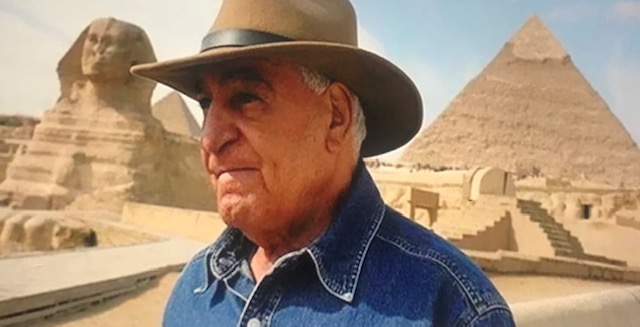The legendary Zahi Hawass, spokesman for ancient Egypt

by Count Federico Wardal ——————————
When it comes to Egypt, scholars bow. Even those who don’t know much about Egypt, but have only seen the image of Tutankhamun’s golden mask, are enchanted.
Egypt’s ancient culture crosses the limits of knowledge and much of it is still mysterious today. Egyptian culture has always focused its gaze on the infinite, calling to itself the unknown. Egypt has built a staircase without limits towards the immense: each point shows a reality which in turn shows another reality, going beyond space and time.
This can be clearly seen when visiting the funeral chambers of the ancient tombs, admiring the paintings which are exact star maps. Egypt perfectly combines life and death, physicality and spirituality and represents both with Beauty in its supreme form. Science and knowledge in Egypt are instruments of beauty. So we can admire sublime and perfect faces carved in granite.
But, great mysteries immediately emerge: it is impossible to imagine that sublime and perfect faces were made in granite 7-8000 years ago without having modern technological means. Another Egyptian cultural goal was to pass on to posterity the image of the great deceased with all the important things they had used in life.
To achieve this goal, to achieve perfect conservation of the human body, the absence of humidity, a constant temperature, and other elements unknown to us are necessary.
The style of Egyptian art, which is metaphysical, is absolute in its uniqueness. There is no previous, contemporary or subsequent civilization to the Egyptian one that was capable of producing such original art. The Greek and Roman civilizations, subsequent to Egypt, certainly represented Beauty as well, but always in a more earthly form. Only since the last century has art, for example abstract art, hovered again towards celestial forms and creatures.
But why has Egyptian civilization, above all others, disappeared? The answer would be simple, but it is not. One answer would be that Egyptian civilization disappeared because it had achieved perfection, the perfect balance in everything. It had accomplished the mission for which it was born.
I said “disappearance”, since our language is inadequate. From another point of view, the Egyptian civilization has never disappeared: its echo, its energy is eternal and is eternally on earth and speaks to us, as it does to all of us. In every instant of our life, nature speaks to us, the universe in an endless motion and cycle.
The sensational discoveries of the mysteries of Egyptian civilization have no end and help us understand, each other, our times, and what our future could be. And here is the importance of a great figure who for decades has given us amazing discoveries. He is a man who wrote 44 books that are invaluable for human knowledge, the engine of our future and survival itself.
For all this, he is considered a living legend: he is the archaeologist Dr. Zahi Hawass. I recently met him in Egypt and San Francisco during his world tour. He is a great man who sees peace and civilization, so he is a worthy son and spokesman for the immense Egyptian civilization. He recently had al-Fath mosque restored in Cairo, St. Mark Cathedral in Alexandria and Moses Ben Maimon Synagogue in Cairo for a strong dialogue of brotherhood among Muslim, Christian and Judaic traditions. https://www.ynetnews.com/articles/0,7340,L-3765207,00.html.
Dr. Hawass also explained to me that there was no slavery in ancient Egypt. Those who built the fabulous and immense funeral monuments and Egyptian temples were people devoted to the pharaohs and divinities who were their life, their cult, their essence and existence. Their work, which often lasted their entire lives, was a tribute to the universe and creation. “They were buried in the sacred places of temples and funeral monuments and for this reason they could not be slaves,” Dr. Hawass tells me.
This year the Great Museum of Giza, the largest museum in the world, will be completed. It is a project that was begun in the 90s. For Egypt, 2002 was a year of enormous historical importance: on January 5, 2002 President Hosny Mubarak laid the foundation stone of the Grand Museum of Giza and on October 16 heads of state and royalty from all over the world were in Alexandria for the reopening of the legendary Bibliotheca Alexandrina presided over by the former First Lady HE Suzanne Mubarak, defender of women’s and children’s rights.
Dr. Hawass has strongly contributed to the conception of the Grand museum of Giza, always in cultural cooperation with the director of the Bibliotheca Alexandrina, Dr. Moustafa El Feki and with the former minister of culture artist Farouk Hosny, inventor of the Cairo International Festival of Experimental Theater.
Hawass has strongly cooperated with UNESCO in carrying out colossal works in Egypt and supported the author of the law against female genital mutilation, H.E. Moushira Khattab, for her recent candidacy as UNESCO ‘s Secretary General.
Dr. Hawass is constantly lecturing in the USA and, as soon as the coronavirus emergency is over, Dr. Hawass will hold the conferences that were scheduled for May.
His speaking calendar is in this link https://hawasslectures.com/. Over the course of millennia, Egypt has undergone various epidemics and has always survived. President El-Sisi has long taken drastic measures against the spread of coronavirus, although there are few cases in Egypt. Egypt and Dr. Hawass wish the world a very rapid resolution of this pandemic, being pleased to reopen the doors to the magic and splendor of Egyptian monuments and museums.
